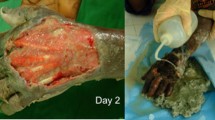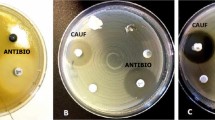Abstract
The worldwide emergence of infectious diseases, together with the increasing incidence of antibiotic-resistant bacteria, elevate the need to properly detect, prevent, and effectively treat these infections. The overuse and misuse of common antibiotics in recent decades stimulates the need to identify new inhibitory agents. Therefore, natural products like clays, that display antibacterial properties, are of particular interest.
The absorptive properties of clay minerals are well documented for healing skin and gastrointestinal ailments. However, the antibacterial properties of clays have received less scientific attention. French green clays have recently been shown to heal Buruli ulcer, a necrotic or ‘flesh-eating’ infection caused by Mycobacterium ulcerans. Assessing the antibacterial properties of these clays could provide an inexpensive treatment for Buruli ulcer and other skin infections.
Antimicrobial testing of the two clays on a broad-spectrum of bacterial pathogens showed that one clay promotes bacterial growth (possibly provoking a response from the natural immune system), while another kills bacteria or significantly inhibits bacterial growth. This paper compares the mineralogy and chemical composition of the two French green clays used in the treatment of Buruli ulcer.
Mineralogically, the two clays are dominated by 1Md illite and Fe-smectite. Comparing the chemistry of the clay minerals and exchangeable ions, we conclude that the chemistry of the clay, and the surface properties that affect pH and oxidation state, control the chemistry of the water used to moisten the clay poultices and contribute the critical antibacterial agent(s) that ultimately debilitate the bacteria.
Similar content being viewed by others
References
Aufreiter, S., Hancock, R.G.V., Mahaney, W.C., Stambolic-Robb, A. and Sanmugadas, K. (1997) Geochemistry and mineralogy of soils eaten by humans. International Journal of Food Science and Nutrition, 48, 293–305.
Bennett, P.C., Engel, A.S., and Roberts, J.A. (2006) Counting and imaging bacteria on mineral surfaces: Pp. 37–78 in: Methods of Investigating Microbial-Mineral Interactions (P.A. Maurice and L.A. Warren, editors). CMS Workshop Lectures, Vol.14. The Clay Minerals Society, Chantilly, Virginia.
Booth, I.R. (1985) Regulation of cytoplasmic pH in bacteria. Microbiology Reviews, 49, 359–378.
Brunet de Courssou, L. (2002) 5th WHO Advisory Group Meeting on Buruli Ulcer, Study Group Report on Buruli Ulcer Treatment with Clay. Geneva, Switzerland.
Carlin, A., Shi, W., Dey, S., and Rosen, B.P. (1995) The ars Operon of Escherichia coli confers arsenical and antimonial resistance. Journal of Bacteriology, 177, 981–986.
Carretero, M.I. (2002) Clay minerals and their beneficial effects upon human health. A review. Applied Clay Science, 21, 155–163.
Carretaro, M.I., Gomes, C.S.F., and Tateo, F. (2006) Clays and human health. Pp. 717–741 in: Handbook of Clay Science (F. Bergaya, B.K.G. Theng, and G. Lagaly, editors). Developments in Clay Science, 1, Elsevier Ltd., Amsterdam.
Cohn, C.A., Mueller, S., Wimmer, E., Leifer, N., Greenbaum, S., Strongin, D.E., and Schoonen, M.A.A. (2006) Pyrite-induced hydroxyl radical formation and its effect on nucleic acids. Geochemical Transactions. Open Access: https://doi.org/www.geochemicaltransactions.com, 11 pp.
Dendrinou-Samara, C., Alevizoupoulou, L., Iordanidis, L., Samaras, E., and Kessissoglou, D.P. (2002) 15-MC-5 manganese metallacrowns hosting herbicide complexes. Structure and bioactivity. Journal of Inorganic Biochemistry, 89, 89–96.
Diamond, J.M. (1999) Dirty eating for healthy living. Nature, 400, 120–121.
Dopson, M., Baker-Austin, C., Koppineedi, P.R., and Bond, P.L. (2003) Growth in sulfidic mineral environments: metal resistance mechanisms in acidophilic micro-organisms. Microbiology, 1490, 1959–1970.
Droy-Lefaix, M.T. and Tateo, F. (2006) Clays and clay minerals as drugs. Pp. 743–753 in: Handbook of Clay Science (F. Bergaya, B.K.G. Theng and G. Lagaly, editors). Developments in Clay Science, 1, Elsevier, Amsterdam.
Eberl, D.D. (2003) Users guide to RockJock: A program for determining quantitative mineralogy from powder X-ray diffraction data. USGS Open file Report 03-78. USGS.
Estrela, C., Sydney, G.B., Bammann, L.L., and Felippe Jr., O. (1994) Mechanism of action of calcium and hydroxyl ions of calcium hydroxide on tissue and bacteria. Brazilian Dental Journal, 6, 85–90.
Feng, Q.L., Kim, T.N., Wu, J., Park, E.S., Kim, J.O., Lim, D.Y., and Cui, F.Z. (1998) Antibacterial effects of Ag-HAp thin films on alumina substrates. Thin Solid Films, 335, 214–219.
Fenton, H.J.H. (1894) Oxidation of tartaric acid in the presence or iron. Journal of the Chemical Society, 65, 899–910.
Ferrand, T. and Yvon, J. (1991) Thermal properties of clay pastes for pelotherapy. Applied Clay Science, 6, 21–38.
Ferris, F.G., Fyfe, W.S., and Beveridge, T.J. (1987) Bacteria as nucleation sites for authigenic minerals in a metal-contaminated lake sediment. Chemical Geology, 63, 225–232.
Franklin, N.M., Stauber, J.L., Markich, S.J. and Lim, R.P. (2000) pH-dependent toxicity of copper and uranium to a tropical freshwater alga (Chlorella sp.). Aquatic Toxicology, 48, 275–289.
Frost, R.L., Ruan, H., Kloprogge, J.T., and Gates, W.P. (2000) Dehydration and dehydroxylation of nontronites and ferruginous smectite. Thermochimica Acta, 346, 63–72.
George, K.M., Chatterjee, D., Gunawardana, G., Welty, D., Hayman, J., Lee, R., and Small, P.L. (2002) Mycolactone: a polyketide toxin from Mycobacterium ulcerans required for virulence. Science, 283, 854–857.
Giese, R.F. and van Oss, C.J. (2002) Colloid and Surface Properties of Clays and Related Minerals. Marcel Dekker, New York.
Goldberg, S. (2002) Competitive adsorption of arsenate and arsenite on oxides and clay minerals. Soil Science Society of America Journal, 66, 413–421.
Hall, R.E., Bender, G., and Marquis R.E. (1987) Inhibitory and cidal antimicrobial actions of electrically generated silver ions. Journal of Oral Maxillofacial Surgery, 45, 779–784.
Haydel, S.E., Remineh, C.M., and Williams, L.B. (2008) Broad-spectrum in vitro antibacterial activities of clay minerals against antibiotic-susceptible and antibiotic-resistant bacterial pathogens. Journal of Antimicrobial Chemotherapy (in press).
Hedges, R.W. and Baumberg, S. (1973) Resistance to arsenic compounds conferred by a plasmid transmissible between strains of Escherichia coli. Journal of Bacteriology, 115, 459–460.
Heller-Kallai, L. and Rozenson, I. (1980) Dehydroxylation of dioctahedral phyllosilicates. Clays and Clay Minerals, 28, 355–368.
Jackson, M.L. (1979) Soil Chemical Analysis-Advanced course. 2nd edition. Published by the author, Madison, Wisconsin 53705, USA.
Johnston, R.B., Keele, B.B., Misra, H.P., Leymeyer, J.E., Webb, L.S., Baehner, R.L., and Rajagopalan, K.V. (1975) The role of superoxide anion generation in phagocytic bactericidal activity. The Journal of Clinical Investigation, 55, 1357–1372.
Kim, J., Dong, H., Seabaugh, J., Newell, S.W., and Eberl, D.D. (2004) Role of microbes in the smectite to illite reaction. Science, 303, 830–832.
Kodukula, P.S., Prakasam, T.B.S. and Antonisen, A.C. (1988) Role of pH in biological wastewater treatment process. Pp. 114–134 in: Physiological Models in Microbiology (M.J. Bazin and J.I. Prosser, editors). 1st edition. CRC Press, Boca Raton, Florida.
Kostka, J.E., Dalton, D.D., Skelton, H., Dollhopf, S., and Stucki, J.W. (2002) Growth of iron (III)-reducing bacteria on clay minerals as the sole electron acceptor and comparison of growth yields on a variety of oxidized iron forms. Applied and Environmental Microbiology, 68, 6256–6262.
Kurkdjian, A. and Guern, J. (1989) Intracellular pH: Measurement and importance in cell activity. Annual Reviews Plant Physiology Plant Molecular Biology, 40, 271–303.
Lanson, B. and Champion, D. (1991) The I-S to illite reaction in the late stages of diagenesis. American Journal of Science, 291, 473–506.
Ma’or, Z., Henis, Y., Along, Y., Orlov, E., Sorensen, K.B., and Oren, A. (2006) Antimicrobial properties of Dead Sea black mineral mud. International Journal of Dermatology, 45, 504–511.
Maple, P.A., Hamilton-Miller, J.M., and Brumfitt, W. (1992) Comparison of the in-vitro activities of the topical antimicrobials azelaic acid, nitrofurazone, silver sulphadiazine and mupirocin against methicillin-resistant Staphylococcus aureus. Journal of Antimicrobial Chemotherapy, 29, 661–668.
Mendonca, A.F., Amoroso, T.L., and Knabel, S.J. (1994) Destruction of gram-negative food-borne pathogens by high pH involves disruption of the cytoplasmic membrane. Applied and Environmental Microbiology, 60, 4009–4014.
Metge, D., Harvey, R., Eberl, D., and Williams, L.B. (2007) Bactericidal properties of clays used for treatment of Buruli ulcer — an emerging public health threat. Geological Society of America, Abstracts with Programs, Denver, Colorado.
Moore, D.M. and Reynolds, R.C. (1997) X-ray Diffraction and the Identification and Analysis of Clay Minerals. 2nd edition. Oxford University Press, New York.
Mullen, M.D., Wolf, D.C., Ferris, F.G., Beveridge, T.J., Flemming, C.A., and Bailey, G.W. (1989) Bacterial sorption of heavy metals. Applied and Environmental Microbiology, 55, 3143–3149.
Nies, D.H. (1999) Microbial heavy-metal resistance. Applied Microbiology Biotechnology, 51, 730–750.
Nies, D.H. and Silver, S. (1995) Ion efflux systems involved in bacterial metal resistances. Journal of Industrial Microbiology, 14, 186–199.
Nolte W.A. (1982) Oral Microbiology. 4th edition. Mosby, London pp. 3–37.
Nordstrom, D.K. (2002) Worldwide occurrences of arsenic in groundwater. Science, 296, 2143–2145.
Norris, J. (1993) Surface free energy of smectite clay minerals, 197 pp. Dissertation, SUNY, Buffalo, New York.
Pollastro, R.M. (1993) Considerations and applications of the illite-smectite geothermometer in hydrocarbon-bearing rocks of Miocene to Mississippian age. Clays and Clay Minerals, 41, 119–133.
Reed, S.J.B. (1993) Electron Microprobe Analysis. 2nd edition. Cambridge University Press, Cambridge, UK, 326 pp.
Rogers, J.R. and Bennett, P.C. (2004) Microbial release and utilization of inorganic nutrients from feldspar, basalt, and glass. Chemical Geology, 203, 91–108.
Schoonen, M.A.A., Cohn, C.A., Roemer, E., Laffers, R., Simon, S.R., and O’Riordan, T. (2006) Mineral-induced formation of reactive oxygen species. Pp. 179–221 in: Medical Mineralogy and Geochemistry (N. Sahai and M.A.A. Schoonen, editors). Reviews in Mineralogy and Geochemistry, 64, Mineralogical Society of America, Chantilly, Virginia, and the Geochemical Society, Washington, D.C.
Środoń, J., Drits, V.A., McCarty, D.K., Hsieh, J.C., and Eberl, D.D. (2001) Quantitative X-ray diffraction analysis of clay bearing rocks from random preparations. Clays and Clay Minerals, 49, 514–528.
Stucki, J.W., Bailey, G.W., and Gan, H. (1996) Oxidation-reduction mechanisms in iron-bearing phyllosilicates. Applied Clay Science, 10, 417–430.
Suzuki, Y. and Banfield, J.F. (1999) Geomicrobiology of Uranium. Pp. 393–432 in: Uranium: Mineralogy, Geochemistry and the Environment (P.C. Burns and R. Finch, editors). Reviews in Mineralogy, 38, Mineralogical Society of America, Washington, D.C.
Suzuki, Y. and Banfield, J.F. (2004) Resistance to and accumulation of uranium by bacteria from a uranium-contaminated site. Geomicrobiology Journal, 21, 113–121.
Uchida, M., Yamamoto, T., Furuhashi, H., Nakata, S., and Nakagawa, Z. (2004) Antibacterial activity of silver ions at a minimum inhibitory concentration. Journal of Antibacterial and Antifungal Agents, 32, 115–121.
van der Werf, T.S., Stinear, T., Stienstra, Y., van der Graaf, W.T., and Small, P.L. (2003) Mycolactones and Mycobacterium ulcerans disease. Lancet, 362, 1062–1064.
van Oss, C.J. (1994) Interfacial Forces in Aqueous Media. 440 pp. Marcel Dekker, New York.
Wackett, L.P., Dodge, A.G., and Ellis, L.B. (2004) Microbial genomics and the periodic table. Applied and Environmental Microbiology, 70, 647–655.
Weast, R.C. (1984) Handbook of Chemistry and Physics. 64th edition. CRC, Boca Raton, Florida.
Weir, E. (2002) Buruli ulcer: the third most common mycobacterial infection. Canadian Medical Association Journal, 166, 1691.
Williams, L.B., Holland, M., Eberl, D.D., Brunet, T., and Brunet de Courssou, L. (2004) Killer Clays! Natural antibacterial clay minerals. Mineralogical Society Bulletin, 139, 3–8.
Wilson, M.J. (2003) Clay mineralogical and related characteristics of geophagic materials. Journal of Chemical Ecology, 29, 1525–1547.
Wolthers, M., Butler, I.B., and Rickard, D. (2007) Influence of arsenic on iron sulfide transformations. Chemical Geology, 236, 217–227.
World Health Organization (2004) Provisional guidance on the role of specific antibiotics in the management of Mycobacterium ulcerans disease (Buruli ulcer). World Health Organization, Geneva, Switzerland.
Author information
Authors and Affiliations
Corresponding author
Rights and permissions
About this article
Cite this article
Williams, L.B., Haydel, S.E., Giese, R.F. et al. Chemical and mineralogical characteristics of French green clays used for healing. Clays Clay Miner. 56, 437–452 (2008). https://doi.org/10.1346/CCMN.2008.0560405
Received:
Revised:
Published:
Issue Date:
DOI: https://doi.org/10.1346/CCMN.2008.0560405




